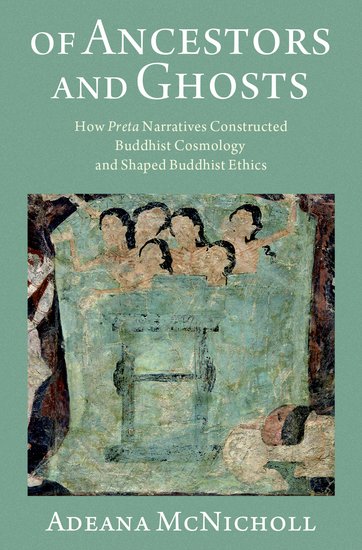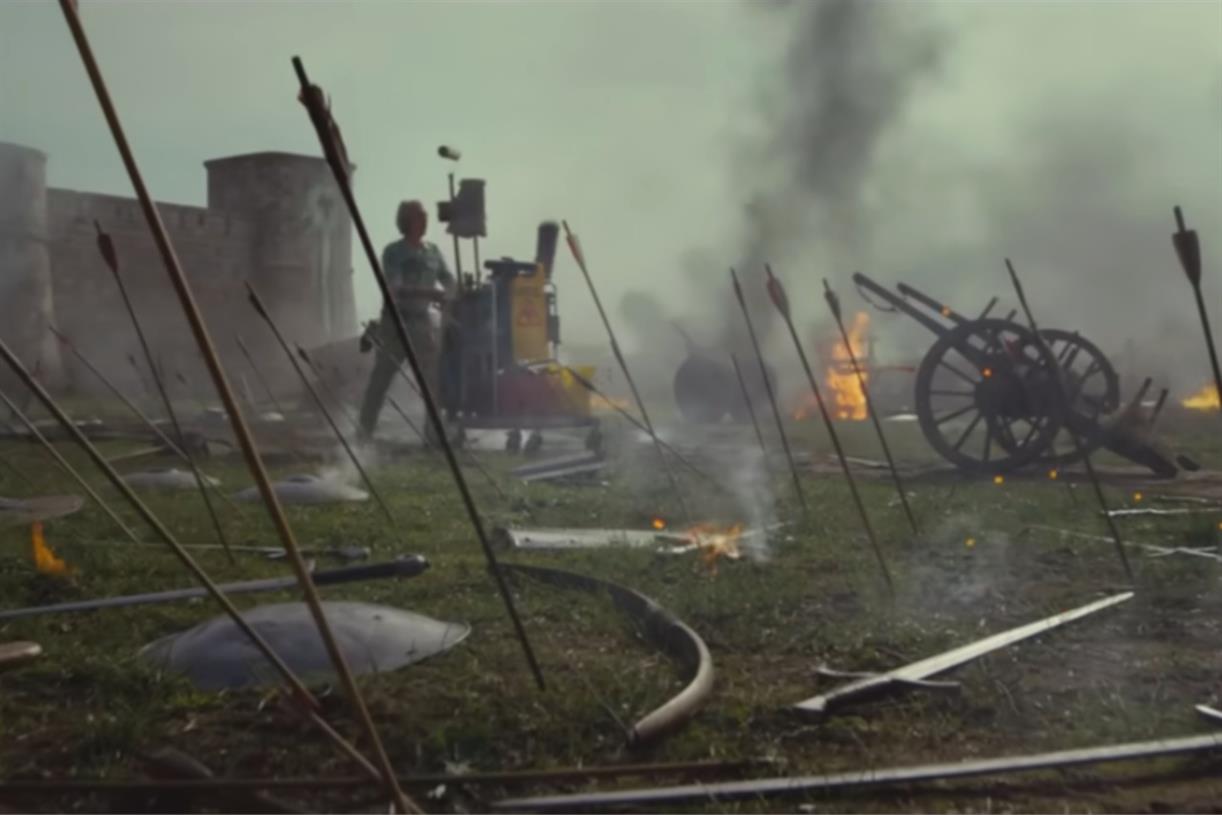Who Were the Hungry Ghosts, Really?
The evolving stories of pretas reveal much about Buddhist views of karma, cosmology, and grief. The post Who Were the Hungry Ghosts, Really? appeared first on Tricycle: The Buddhist Review.

Long ago, a group of individuals obstructed an almsgiving ceremony, ate the alms, and set fire to the dining hall. For this, they suffered in hell for ninety-two eons before being reborn as pretas [Skt.; Pali: peta] during the time of the Buddha Kassapa. One day, they witnessed others giving alms for their departed relatives, who were then reborn in heaven. They approached Kassapa, who told them that in a future age, when the Buddha Gotama appears, a relative of theirs would offer alms on their behalf. That relative would be King Bimbisara.
When the time came, the pretas eagerly gathered as Bimbisara invited the Buddha to his residence. But Bimbisara forgot to make the dedication. That night, the king heard the pretas wailing in anguish. Frightened, Bimbisara went to the Buddha, who explained the situation to him. So, Bimbisara made another offering—of water, food, clothes, and lodging—and dedicated it to his former relatives. The pretas received the benefits. Their bodies were transformed, their thirst quenched, and their hunger satisfied. They even received celestial clothes and mansions.
This story, found in the “Outside the Walls Peta Tale,” illustrates a central Buddhist teaching: our actions in this life shape not only our own lives but the lives of others—even beyond death.
We might best know pretas (Pali: peta) as hungry ghosts occupying one of the lower realms of rebirth. This is how they are depicted in the wheel of samsara, a visual representation of Buddhist teachings on karma and rebirth. In these images, pretas appear as pitiful creatures with large, bloated stomachs and mouths (or throats) as small as the eye of a needle. They yearn to satiate their hunger and thirst, yet cannot consume food, either because their bodies are ill-suited to such an endeavor or because the food will burst into flames or transform into insects or foul substances. They occupy such an existence, we are told, because of the stinginess they displayed in a prior lifetime.
Where pretas are viewed as ethically significant for the Buddhist tradition, it is usually in relation to their use as psychological metaphors. For example, hungry ghosts are often understood as a metaphor for a state of mind consumed by greed. For some Buddhists, pretas remind us of the consequences of dwelling in a state of constant desire or remaining too attached to material possessions. For others, pretas act as a metaphor for a state of addiction, in which we constantly yearn for something that can never satisfy us. However, in many early Buddhist texts, pretas are deceased family members whose fate is intertwined with the generosity of the living. Understanding how pretas evolved from ancestral spirits to beings trapped in a karmic cycle of suffering provides insight into the development of Buddhist cosmology over time.
In this regard, the second central lesson of the “Outside the Walls Peta Tale” is that we can help those who have passed. Today, one of the primary ways Buddhists interact with ghosts is through rituals, such as those conducted during the Ghost Festival in East and Southeast Asia. The origin of this festival is traced back to China and the story of the monk Mulian, also known as Maudgalyayana. Mulian, upon discovering that his mother had been reborn in the underworld, strived to free her from that realm. The Buddha instructed him to give offerings on her behalf to the sangha on the fifteenth day of the seventh lunar month. These offerings would allow his mother to be freed from her suffering and reborn elsewhere. During this time of year, laypeople and monks prepare for the journey of the ghosts from the underworld by presenting offerings to both ghosts and ancestors.
Preta stories are serious ways of trying to answer questions like what happens to people after they die, how we should respond to the death of a loved one, and how we can best assist the departed in the next life.
Tales of humans engaging in immoral behavior and being reborn as suffering ghosts have often been interpreted as scare tactics to encourage laypeople and monks alike to lead ethical lives, generate merit, and donate to the sangha. There is truth to this—these stories are intended to shock listeners and readers out of their complacency so that they will take action to secure their fate in the next world and extend care to the departed. However, these stories also offer more to the development of the Buddhist tradition than mere metaphorical scare tactics for laypeople. They are serious ways of trying to answer questions like what happens to people after they die, how we should respond to the death of a loved one, and how we can best assist the departed in the next life. They were also ways to consider what it meant to be embodied within a karmic world system.
Far from simple didactic tales, preta stories were an important tool through which Buddhists constructed cosmological ideas and shaped ethical thinking, particularly around actions and their fruits, which were an important part of the religious ethos that structured moral possibilities. The Sanskrit term preta means departed, hinting at the preta’s early origins in South Asia, not as reincarnated “hungry” ghosts but as deceased individuals. When we look at the earliest collection of preta narratives, Tales of the Departed (Petavatthu), found in the Pali canon’s Khuddaka Nikaya, we find pretas appearing in various forms. To be sure, there are several hungry and thirsty reincarnated ghosts. But some pretas live in celestial mansions, enjoy the luxuries of heaven, and have sex lives. Still others appear as departed loved ones to whom we should dedicate alms.
The preta’s history begins before the emergence of Buddhism. Brahmans had a long history of addressing the fate of the departed. By the time of the Buddha, Brahmans developed rituals known as śrāddha rites to assist the dead. Once people died, they became disembodied pretas, who needed their living relatives to perform the ritual so they could transition to the ancestral realm. These rites involved offerings to priests, who acted as intermediaries between the living and the departed. Individuals whose family members failed to perform the rites would be stuck as pretas, potentially haunting their descendants and ruining their sacrificial offerings.
This Brahmanical worldview—performing rituals to promote ancestors to an eternal heaven— operated in tension with new ideas about samsara, the continuous cycle of death and rebirth. For Buddhists, this raised questions about the afterlife, how the departed are affected by karmic actions, and the role of rituals in aiding them. Answers regarding what to do with the preta differed based on religious tradition. Buddhists accepted that there are things called pretas in the world and that they do need ritual action from the living. But over time, pretas shed their identity as the generic departed, increasingly being allotted their own realm of rebirth. Buddhists proposed that pretas aren’t just any departed relatives but specifically those reborn in the preta realm.
 Buddhist hungry ghosts realm in Wheel of Time mural painting in a Tibetan Nyingma Monastery in Bodhgaya Bihar, India. Image via Maciej Wojtkowiak / Alamy Stock Photo.
Buddhist hungry ghosts realm in Wheel of Time mural painting in a Tibetan Nyingma Monastery in Bodhgaya Bihar, India. Image via Maciej Wojtkowiak / Alamy Stock Photo.We can witness this transition in Buddhist narrative literature. Many stories where pretas appear as a departed relative are emotionally poignant, speaking to the grief that one might feel upon the death of a loved one. In one story from Tales of the Departed, the “Biscuit Doll Peta Tale,” a little girl accidentally breaks her doll, whom she had regarded as her daughter. She is inconsolable. Finally, her great-grandfather, Anathapindika, comforts her by offering alms to the sangha on behalf of her “daughter.” This leads the Buddha to expound on the benefits of giving alms for the departed. This tale’s child-like grief throws into relief other stories featuring adults who lose themselves in excessive lamentation over their departed loved ones.
One famous example, though not included in the Tales of the Departed, is that of the “Parable of the Mustard Seed,” where the mother Kisagotami carries the body of her dead son door-to-door, seeking a means to revive him. She can only process her grief appropriately when the Buddha teaches her about the ubiquity of death. In Tales of the Departed, we also find stories of men who succumb to interminable grief upon the death of their relatives. They are visited by their departed relatives, learn about the Buddha’s teaching on impermanence, and are encouraged to channel such grief toward providing offerings to the dead.
By encouraging us to channel our grief into more fruitful endeavors, Buddhists utilize such stories to position themselves in relation to other ideas about the departed in South Asia. Like Brahmans, Buddhist monks cast themselves as ideal ritual mediators between the living and the dead. Preta stories reject the notion that we should—or can—give offerings directly to pretas. Individuals who attempt to do so frequently watch their offerings disappear, burst into flames, or transform into foul substances. Instead, the living are told to direct those offerings to the sangha. Some of these rituals appear to preserve a memory of the śrāddha rite. In earlier tales, individuals dedicate offerings of food, water, clothing, and shelter, which immediately materialize for the preta in their world. This process is illustrated in the “Outside the Walls Peta Tale,” which continues to be used in funerary rituals in Sri Lanka and in ghost festivals in Southeast Asia today.
Over time, Buddhists developed a more moral and karmic framework for these rituals, portraying the ritual’s climax—the dedication of the offering—as involving merit, which helps the preta be reborn in a better location. Whereas Tales of the Departed represents a period of transition in ideas about rites for the departed, Sanskrit literature firmly situates these rituals within the context of dedicating merit. This is seen in the Avadānaśataka, or One Hundred Stories, translated by Andy Rotman. In this collection, pretas are typically described according to a standard set of characteristics that more closely fit our image of the hungry ghost. The rituals on their behalf involve a dedication of merit that goes to the pretas, allowing them to leave the preta realm.
Reframing rituals for the departed took place alongside and in conversation with the articulation of the preta’s identity. Over time, the term “preta” increasingly described not just any departed individual but specifically the inhabitants of a particular category of rebirth. Far from being a heavenly realm of the ancestors, the Buddhist preta realm became increasingly characterized as an unfortunate realm populated by the suffering dead. The Janussoṇi Sutta in the Pali canon’s Aṅguttara Nikaya, for example, documents an exchange between certain Brahmans and the Buddha. The Brahmans ask if the śrāddha rite can truly help their departed relatives. In response, the Buddha explains that it does, but it only helps individuals who have been reborn in the preta realm. This exchange demonstrates how Buddhists incorporated ancestral imagery and rituals into their practices, even as they reshaped them to suit a new identity for the preta as the reincarnated suffering dead, and an evolving ritual context increasingly centered on merit.
These stories are more than simple scare tactics to encourage proper ethical behavior.
Incorporating the pretas into the Buddhist cosmos involved choosing among various alternatives. While other traditions, such as Jainism, excluded the preta realm from their cosmology, Buddhists integrated it into a karmic framework, reshaping earlier ideas about the dead. In arguing for the realm of the pretas as one comprising reincarnated ghosts, these stories helped construct Buddhist cosmology as we know it today. The question of the preta’s identity was not only bound up with visions of the world but also with the notion of causality and karma itself. By making pretas the subject of narratives, by giving them a voice, personalities, and feelings, Buddhist authors demonstrated that (1) there are fruits for our actions in the next world; (2) making offerings on behalf of the dead bears fruit; and (3) these offerings are best directed toward Buddhist monks. As these stories are inherently concerned with actions and their fruits, they contribute to the broader ethical imagination of the Buddhist worldview.
In ancient South Asia, not everyone found the Buddhist understanding of causality convincing, nor did all communities that believed actions have fruit in the next world agree on the particulars behind this process. Tales of the Departed critiques materialists who deny life after death and fatalists who dismiss the role of actions in shaping future lives. Both views were seen as misaligned with Buddhist teachings on karma and the power of making offerings to the departed.
To such communities, pretas serve as tangible evidence that there is life after death, that ethical actions play a role in shaping the contours of that life, and that it is possible, by giving offerings to the sangha, to help those in the next world. In this sense, pretas’ bodies, by enacting the drama of karma in all its horrific potential, helped shape broader perceptions about ethical action. However, pretas also play an active role in this process. They not only vividly display karma’s effects on their bodies but also use these bodies as teaching tools to facilitate their ability to instruct humans about the Buddhist concepts of karma and causality. As a result, these stories are more than simple scare tactics to encourage proper ethical behavior. They also expand and explore teachings on karma.
Tales of the Departed includes stories of individuals like the miserly Culasetthi and skeptical Nandaka, who are reborn as suffering pretas due to their disbelief in giving offerings. Through the actions of their surviving relatives, they witness the power of almsgiving and merit in transforming their karmic fate. They then go on to teach others, such as Buddhist kings, about karma and the importance of giving alms for the dead.
Such stories are intended to shake us from our complacency. The shock generated by encountering and hearing about pretas enables characters in these stories—and the external audience—to develop confidence in the Buddha’s teachings on karma, as well as the corresponding mental clarity that inspires one to strive for their future well-being. The emotional response to stories about pretas is intended to be ethically formative.
Pretas serve as tangible evidence that there is life after death, that ethical actions play a role in shaping the contours of that life, and that it is possible, by giving offerings to the sangha, to help those in the next world.
Other karmic tales also develop Buddhist teachings on the nature of actions and their consequences. But there is perhaps something uniquely impactful about preta stories. On the one hand, this is because the question of life after death and the role of our actions in shaping that life is of central concern to preta literature. The concept of karma is pivotal to the creation of the preta realm and its inhabitants. On the other hand, pretas frequently maintain their prior familial connections, providing additional significance to the teachings on karma. Pretas feel particularly close to us because they are our wives, husbands, children, parents, and grandparents—in a more literal than theoretical sense. Despite the preta’s gradual solidification into the reincarnated hungry ghost, the connection with the ancestral departed never entirely disappeared.
In addition to addressing pressing questions about the nature of the afterlife and the relationship between the living and the dead, preta literature was also crucial for developing key concepts in the Buddhist tradition. This includes not only ideas about karma but notions of what the world looks like, how it is structured, and how we move through it. In this way, these stories function in a similar way to the wheel of samsara, which, in presenting pretas as thoroughly integrated within a multi-realm cosmology, both argues for the integration of the preta realm as a separate realm of rebirth and represents the culmination of a longer tradition of ideas about pretas. The fact that narrative literature helped construct the Buddhist preta as a “hungry ghost” and, with it, the preta realm, demonstrates that ideas about cosmology are not only formed through doctrinal treatises but are woven together through a long, uneven, and aggregate process. Far from being simple morality tales, preta stories helped refine and develop Buddhist thinking about cosmology, karma, and ethical action.
*
To learn more about pretas and their role in Buddhism, see Of Ancestors and Ghosts: How Preta Narratives Constructed Buddhist Cosmology and Shaped Buddhist Ethics (Oxford University Press, 2024) by Adeana McNicholl.

 Kass
Kass 
































